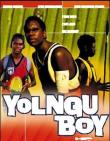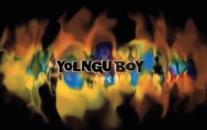AustLit
Latest Issues
AbstractHistoryArchive Description
'Caught in a collision between the modern world of rap, football, street cred and the oldest living culture on earth, Lorrpu, Botj and Milika are three teenagers who once shared a childhood dream of becoming great hunters together. But things have changed and their paths are diverging. The film is about the search for identity, making the journey from adolescence to adulthood and the implications of belonging to a larger social group, whether it be culture, a family or a group of friends'.
Source : http://librariesaustralia.nla.gov.au/ (Sighted 8 July 2009).
Notes
-
Study guide available online
Publication Details of Only Known VersionEarliest 2 Known Versions of
Works about this Work
-
Aboriginal Perspectives in English Classroom Texts
2019
single work
criticism
— Appears in: English in Australia , vol. 54 no. 1 2019; (p. 20-29)'According to the NSW K–10 English Syllabus, all students should engage with ‘texts that give insight into Aboriginal experiences in Australia’. Along with the inclusion of the Aboriginal and Torres Strait Islander Cross Curriculum Priority, this suggests that texts in English should develop deep understanding of Aboriginal cultures, experiences and perspectives. This project uses critical discourse analysis followed by content analysis, adapted from Lowe and Yunkaporta’s (2013) Cultural Analysis Matrix, to analyse representations of Aboriginal experiences and perspectives in six commonly used classroom texts to ascertain the nature and depth of the Aboriginal voices, experiences and perspectives within each text. This paper argues that texts which include Aboriginal characters and experiences through non-Aboriginal perspectives remain at risk of tokenism and/or shallow inclusion. However, texts which embody and value Aboriginal ways of knowing, doing and being demonstrate a capacity for more nuanced and genuine insights into Aboriginal experiences in Australia.'
Source: Publisher's blurb.
-
Seriously Funny : History and Humour in The Sapphires and Other Indigenous Comedies
2012
single work
criticism
— Appears in: Senses of Cinema , July no. 63 2012; 'The Sapphires (Wayne Blair, 2012) opens in an idyllic rural setting. A group of young Aboriginal girls run home across the paddocks in the fading evening light to sing for a gathering of family and friends. But this benign atmosphere rapidly switches to terror as white Australian Government officials arrive on the scene and forcibly remove one of the girls from the Cummeraganja Mission community. It is the late 1960s, and State and Federal Government "child protection" policies allow the removal of so-called "half-caste" Aboriginal children from their families, leaving a devastating and traumatic legacy that the film goes on to address.' (Author's introduction)
-
Reconciliation and the History Wars in Australian Cinema
2012
single work
criticism
— Appears in: Exhuming Passions : The Pressure of the Past in Ireland and Australia 2012; (p. 207-222) 'When The Proposition ( a UK/Australia co-production, directed by John Hillcoat and scripted by Nick Cave) was released in 2005, film reviewers had no qualms about claiming this spectacular saga of colonial violence on the Queensland frontier as a 'history' film. A reviewer on BBC Radio 4 described The Proposition as 'a bushranger Western...set in violent 1880s Australian outback exposing the bitter racial tensions between English and Irish settlers. A Sunday Times review declared that 'Australia's brutal post-colonial history is stripped of all the lies in a bloody clash of cultures between the British police, the Irish bushrangers and the Aborigines.' Foregrounding the film's revisionist spectacle of colonial violence, an Australian reviewer predicted that, despite 'scenes of throat-cutting torture, rape and exploding heads...The Proposition could be the most accurate look at our national history yet'. (Author's introduction, 207)
-
Top 10 Indigenous Films
2009
single work
column
— Appears in: The Sunday Mail , 20 December 2009; (p. 12-13) -
Inconvenient Truths
2009
single work
criticism
— Appears in: The Weekend Australian , 27-28 June 2009; (p. 6-7) 'While Australian filmmakers and drama producers are beginning to acquaint audiences with the brutal facts of life in many remote communities, the same cannot be said of Australian novelists.'
-
Film
2001
single work
review
— Appears in: Muse , March no. 204 2001; (p. 16)
— Review of Yolngu Boy 2000 single work film/TV -
Teenage Rites Of Passage In The Top End
2001
single work
review
— Appears in: The Age , 22 March 2001; (p. 5)
— Review of Yolngu Boy 2000 single work film/TV -
Cultural Divide
2001
single work
review
— Appears in: Herald Sun , 22 March 2001; (p. 43)
— Review of Yolngu Boy 2000 single work film/TV -
Untitled
2001
single work
review
— Appears in: Senses of Cinema , April-May no. 13 2001;
— Review of Yolngu Boy 2000 single work film/TV -
A cult of immortality in the fumes
2001
single work
column
— Appears in: The Weekend Australian , 30 June-1 July 2001; (p. 1) -
Inconvenient Truths
2009
single work
criticism
— Appears in: The Weekend Australian , 27-28 June 2009; (p. 6-7) 'While Australian filmmakers and drama producers are beginning to acquaint audiences with the brutal facts of life in many remote communities, the same cannot be said of Australian novelists.' -
Aftershock and the Desert Landscape in Heaven's Burning, The Last Days of Chez Nous, Holy Smoke, Serenades, Yolgnu Boy and The Missing
2004
single work
criticism
— Appears in: Australian Cinema after Mabo 2004; (p. 75-93) In this chapter Collins and Davis 'are intersted in how a familiar icon of Australian cinema, the landscape (in particular the desert landscape, the outback), is suddenly made strange (unbearable even) by a historic event and how this raises questions to do with historical amnesia, shock and memory in a national cinema. In order to sneak up on on this post-Mabo experience of aftershock, we want to place these films in relation to threee critical categories which have been important in making sense of the ad hoc diversity of Australian films.' Source : Australian Cinema After Mabo (2004) -
Top 10 Indigenous Films
2009
single work
column
— Appears in: The Sunday Mail , 20 December 2009; (p. 12-13) -
The Rules of Being Australian
2003
single work
criticism
— Appears in: Senses of Cinema , March-April no. 25 2003; This discussion of the recent film Australian Rules explores the complexities of 'representation' in both art and politics.
Awards
- Arnhem Land, Top End, Northern Territory,





